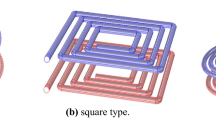Abstract
Wireless power transfer (WPT) is becoming increasingly popular in stationary electric vehicle charging. Unfortunately, the adverse health effects due to the stray magnetic field created by the WPT coils have increasingly caused concern. However, the traditional stray magnetic field optimization design method based on finite element simulation is time-consuming and resource intensive. In this paper, a numerical method to reduce the stray magnetic field around the asymmetrical wireless power transfer coils is proposed while maintaining the transmission power constant. The formulas of the stray magnetic field around the WPT coils are derived, and the distribution characteristics of the stray magnetic field are analyzed in detail. The stray magnetic field around the asymmetrical wireless power transfer coils is optimized by the numerical method, and the number of the turns for the WPT coils corresponding to the minimum stray magnetic field intensity is obtained. The effectiveness of the numerical method is verified via the finite element analysis tool JMAG, and it is proved that the numerical method require less computational time than the finite element simulation. The experiments have also been carried out to evaluate the validity of the theoretical analysis.













Similar content being viewed by others

References
Hui SYR, Zhong WX, Lee CK (2014) A critical review of recent progress in mid-range wireless power transfer. IEEE Trans Power Electron 29(9):4500–4511
Covic GA, Boys JT (2013) Modern trends in inductive power transfer for transportation applications. IEEE J Emerg Sel Top Power Electron 1(1):28–41
Li S, Mi CC (2015) Wireless power transfer for electric vehicle applications. IEEE J Emerg Sel Top Electron 3(1):4–17
Bosshard R, Kolar JW (2016) Inductive power transfer for electric vehicle charging: technical challenges and tradeoffs. IEEE Power Electron Mag 3(3):22–30
Wang CS, Stielau OH, Covic GA (2005) Design considerations for a contactless electric vehicle battery charger. IEEE Trans Industr Electron 52(5):1308–1314
Garnica J, Chinga RA, Jenshan L (2013) Wireless power transmission: from far field to near field. Proc IEEE 101(6):1321–1331
Villa JL, Sallan J, Sanz Osorio JF (2012) High- misalignment tolerant compensation topology For ICPT Systems. IEEE Trans Industr Electron 59(2):945–951
Esteban B, Sid-Ahmed M, Kar NC (2015) A comparative study of power supply architectures in wireless EV charging systems. IEEE Trans Power Electron 30(11):6408–6422
Zhang W, White JC, Malhan RK, Mi CC (2016) Loosely coupled transformer coil design to minimize EMF radiation in concerned areas. IEEE Trans Veh Technol 65(6):4779–4789
C95.1–2005 IEEE Standard for Safety Levels with Respect to Human Exposure to Radio Frequency Electromagnetic Fields, 3 kHz to 300 GHz, IEEE SCC28, IEEE Standards Department, International Committee on Electromagnetic Safety, The Institute of Electrical and Electronics Engineers, New York, (2005)
Budhia M, Covic GA, Boys JT (2011) Design and optimization of circular magnetic structures for lumped inductive power transfer systems. IEEE Trans Power Electron 26(11):3096–3108
Ding P, Bernard L, Pichon L et al (2014) Evaluation of electromagnetic field in human body exposed to wireless inductive charging system. IEEE Trans Magn 50(2):265–274
Liu C, Guo Y, Sun H et al (2014) Design and safety considerations of an implantable rectenna for far-field wireless power transfer. IEEE Trans Antennas Propag 62(11):5798–5806
Chen XL, Umenei AE, Baarman DW et al (2014) Human exposure to close-range resonant wireless power transfer systems as a function of design parameters. IEEE Trans Electomagnetic Compat 56(5):1027–1034
ICNIRP (1998)-International Commission on Non-Ionizing Radiation Protection: Guidelines for Limiting Exposure to Time-Varying Electric, Magnetic, and Electromagnetic Fields (up to 300 GHz)
ICNIRP (2010)- International Commission on Non-Ionizing Radiation Protection: Guidelines for limiting exposure to time-varying electric and magnetic fields(1 Hz–100 kHz)
Kim H, Song C, Kim J, et al (2014) Design of magnetic shielding for reduction of magnetic near field from wireless power transfer system for electric vehicle. In: Proc International symposium on electromagnetic compatibility, Gothenburg, vol 2014: pp 53-58
Lu M, Ngo KDT (2016) Pareto fronts for coils’ efficiency versus stray magnetic field in inductive power transfer. In: Proc IEEE PELS workshop on emerging technologies: wireless power (WoW), Knoxville, TN, vol 2016: pp 1-5
Lu M, Ngo KDT (2018) A fast method to optimize efficiency andstray magnetic field for inductive-power transfer coils using lumped-loops Model. IEEE Trans Power Electron 33(4):3065–3075
Li HC, Li J, Wang KP et al (2014) A maximum efficiency point tracking control scheme for wireless power transfer systems using magnetic resonant coupling. IEEE Trans on Power Electron 30(7):3998–4008
Liu F, Yang Y, Jiang D et al (2017) Modeling and optimization of magnetically coupled resonant wireless power transfer system with varying spatial scales. IEEE Trans on Power Electron 32(4):3240–3250
Morse P, Feshback H (1953) Methods of theoreical physics. McGraw-Hill, New York
Acknowledgements
Manuscript submitted in June 16, 2020. This work was supported in part by the National Natural Science Foundation of China under and Grant 51577123
Author information
Authors and Affiliations
Corresponding author
Additional information
Publisher's Note
Springer Nature remains neutral with regard to jurisdictional claims in published maps and institutional affiliations.
Rights and permissions
About this article
Cite this article
Zhang, W., Song, J., Lin, L. et al. A Numerical Method to Reduce the Stray Magnetic Field Around the Asymmetrical Wireless Power Transfer Coils for Electric Vehicle Charging. J. Electr. Eng. Technol. 17, 1859–1871 (2022). https://doi.org/10.1007/s42835-021-00948-6
Received:
Revised:
Accepted:
Published:
Issue Date:
DOI: https://doi.org/10.1007/s42835-021-00948-6



